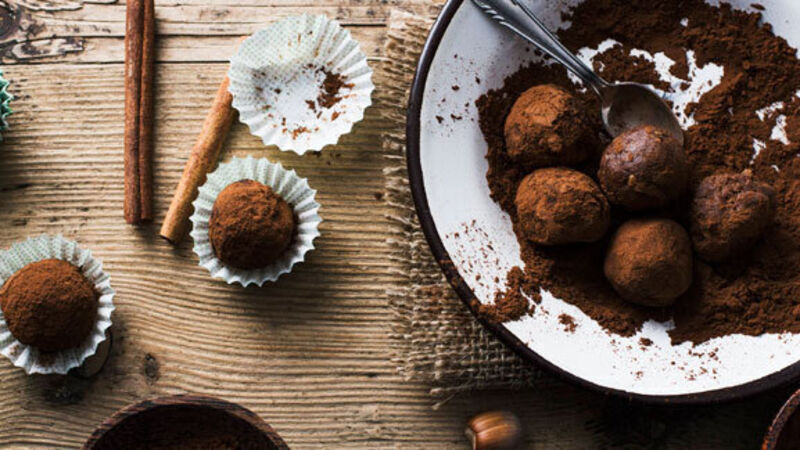Why we love chocolate

It was a bitter love affair until the the marriage of chocolate and sugar created a sweet confection known as ‘the food of the gods’ and often considered an aphrodisiac, says .
To appreciate the flavour of good-quality chocolate, Niki Segnit, author of The Flavour Thesaurus, advises you to push a piece to the roof of your mouth and let it melt.
“The more sweetened the chocolate, the quicker it will reveal its flavour. As you work your way up the cocoa percentages [the less sweetened the chocolate], you’ll notice that it takes longer for the flavour to develop.”
She then directs to us to consider all sorts of chocolate pairings: from the well-known ones, like chocolate and pear and chocolate and vanilla, to more unusual combinations, like chocolate and bacon, chocolate and thyme, and chocolate and cheese (more of this later).
But she makes no mention, I’m afraid, of that peculiarly Irish pairing of milk chocolate with cheese-and-onion crisps.
This last combination satisfies the desire for contrasts: the salt-and-sugar hit played against the crunchy crisps and creamy chocolate. The lovely tension between chocolate and crisps is just too close to the eating habits of them masses, too vulgar even, to be included in serious books about taste and flavour.
And the increased availability of what might be viewed as superior-quality chocolate has encouraged us to become more sophisticated in our relationship with the ‘food of the gods’.
There is a vocabulary for assigning and gauging quality: the ‘snap’ of the chocolate, the complexity of flavours, and the mouth feel.
And to up your snob quotient, Richard Wolke, author of What Einstein Told His Cook 2, instructs us to “talk about [chocolate] in terms taken from a wine magazine (bouquet, fruit, finish and so on).”
It might be easy to dismiss our fascination with chocolate as yet another fleeting food fad. It is also too easy to divide chocolate into the ‘bad chocolate’ and ‘good chocolate’ camps and a lot of the ‘bad chocolate’ is valued for reasons outside considerations of quality.
For instance, chocolate bars have comforting and emotion-filled memory associations, and no end of ‘good chocolate’ could ever replace the power of the ‘bad’ in evoking this tangle of emotion-memory-nostalgia.
Granted, it’s true, there’s a lot of bad chocolate, and those of a certain generation will lament the change in taste and texture of popular chocolate brands.
The European Union’s 2003 ruling to allow up to 5% of the cocoa butter in chocolate to be replaced with other vegetable fats did nothing to improve the reputation of mainstream chocolate and it might have prompted more discerning consumers to consider how chocolate is produced and to question the role of non-chocolate additives.
So the search for good-quality chocolate has brought us greater diversity and choice. There is some superlative chocolate now, with some chocolate-makers sourcing, importing, and processing their own beans to produce bean-to-bar chocolate.
This is a remarkable development, given the complex steps involved in producing chocolate. But as Harold McGee points out in Food and Cooking, “chocolate is one of our most remarkable foods”.
It is bitter in its natural, unprocessed state, only gaining flavour profiles during the fermentation and roasting of the cacao beans.
But chocolate is a remarkable food for reasons beyond its wonderful flavour complexity. Dark chocolate is seductive and versatile; the milk kind is deliciously playful — think Buttons or Smarties — and, of course, all chocolate promises a very pleasurable and sensual eating experience.
Need I mention those Flake ads? And what is possibly most remarkable of all is that it is a food whose full potential was first revealed in industrial manufacture.
For most of its history in Europe, chocolate was enjoyed as a drink and not as a solid confection. When Europeans first encountered chocolate in the New World, the potential of the chocolate beans to be transformed into a smooth, silky hot drink, wasn’t immediately obvious.
In its native home of equatorial South America and in the areas where the cultivation of the trees had spread, the cacao beans were crushed, mixed with various liquids, and drunk flavoured with aromatic flowers, chilli, annatto, and wild honey.
Back home in Europe (and reputedly under Spanish influence), chocolate’s fate was transformed once it paired up with another New World import — sugar.
The marriage of chocolate and sugar transformed this bitter and astringent food into something that would soon be marketed as an indulgence, an exotic, an aphrodisiac. And as early as the mid-seventeenth century, it was satirised and promoted as a food that was linked with the frivolity and leisure activities of women, both inside and outside their bedrooms.
But chocolate was not without its problems: managing the oiliness of the butter fat was one concern; the other was the gritty texture of the chocolate cakes/tablets.
The grit levels were determined by the sophistication, or otherwise, of the techniques involved in crushing beans into chocolate liquor (the resultant paste of hard grinding the beans).
Dutch and Swiss manufacturers lead the charge in producing smooth and better-tasting chocolate, but, from the 1880s onwards, it was a boom time for English companies like Cadbury’s and Fry’s.
These developments, coupled with the falling price of sugar, saw chocolate become a mainstream commodity and a raft of chocolate confections were marketed for special occasions of indulgence.
Now, Easter is our biggest chocolate festival and if you have some lying around after last weekend, looking a bit jaded out of its colourful wrapping, perhaps you could perk it up with some interesting pairings.
Let’s go back to Nicki Segnit’s chocolate and cheese. After paring a variety of chocolate with different British goat’s cheese and blues, she notes that the revelation was the pairing of West Cork Milleens with an 85% Valrhona African – sounds extra good to me!











